-
The object of semasiology.
Two approaches to the study of meaning. -
Types of meaning.
-
Meaning and motivation.
3.1.
The branch of lexicology which studies meaning is called
«semasiology«.
Sometimes the term «semantics»
is used as a synonym to semasiology, but it is ambiguous as it can
stand as well for (1)
the expressive aspect of language in general and (2)
the meaning of one particular word.
Meaning
is certainly the most important property of the word but what is
«meaning»?
Meaning
is one of the most controversial terms in lexicology. At present
there is no generally accepted definition of meaning. Prof.
Smirnitsky defines meaning as «a certain reflection in the mind
of objects, phenomena or relations that makes part of the linguistic
sign, its so-called inner facet, whereas the sound form functions as
its outer facet». Generally speaking, meaning can be described
as a component of the word through which a concept is communicated,
enabling the word to denote objects in the real world.
There are
two
approaches
to the study of meaning: the
referential approach
and the
functional approach.
The former tries to define meaning in terms of relations between the
word (sound form), concept (notion, thought) and referent (object
which the word denotes). They are closely connected and the
relationship between them is represented by «the semiotic
triangle» ( = the basic triangle) of Ogden and Richards (in the
book «The Meaning of Meaning» (1923) by O.K. Ogden and I.A.
Richards).

symbol
referent
(sound form)
This view denies a direct link
between words and things, arguing that the relationship can be made
only through the use of our minds. Meaning is related to a sound
form, concept and referent but not identical with them: meaning is a
linguistic phenomenon while neither concept nor referent is.
The
main criticism of this approach is the difficulty of identifying
«concepts»: they are mental phenomena and purely
subjective, existing
in the minds of individuals. The strongest point of this approach is
that it connects meaning and the process of nomination.
The functional approach to
meaning is less concerned with what meaning is than with how it
works. It is argued, to say that «words have meanings»
means only that they are used in a certain way in a sentence. There
is no meaning beyond that. Ludwig Wittgenstein (1889-1951), in
particular, stressed the importance of this approach in his dictum:
«The meaning of the word is its use in the language». So
meaning is studied by making detailed analyses of the way words are
used in contexts, through their relations to other words in speech,
and not through their relations to concepts or referents.
Actually,
the functional approach is basically confined to the analysis of
sameness or difference of meaning. For example, we can say that in
«take
the bottle»
and «take
to the
bottle»
take
has different meaning as it is used differently, but it does not
explain what the meaning of the verb is. So the functional approach
should
be used not as the theoretical basis for the study of meaning, but
only as complementary to the referential approach.
3.2.
Word meaning is made up of different components, commonly known
as types
of meaning.
The two main types of meaning are grammatical
meaning and
lexical meaning.
Grammatical
meaning
belongs to sets of word-forms and is common to
all words of the given part of speech,
e.g.
girls,
boys, classes, children, mice
express the meaning of
«plurality».
Lexical
meaning
belongs to an individual word in all its forms. It
comprises several components. The two main ones are the
denotational
component and
the connotational component.
The
denotational (
=
denotative)
component,
also called «referential
meaning» or «cognitive meaning», expresses the
conceptual (notional)
content of a word; broadly, it is some information, or knowledge,
of the real-world object that the word denotes.
Basically, this is the component that makes communication possible.
e.g.
notorious
«widely-known»,
celebrated «known
widely».
The
connotational (connotative) component
expresses the attitude of
the speaker to what he is saying, to the object denoted by the word.
This component consists of emotive
connotation and
evaluative connotation.
1) Emotive
connotation
( = «affective meaning», or an emotive charge),
e.g.
In «a
single tree»
single states that there is only one tree,
but
«a
lonely tree»
besides giving the same information, also renders
(conveys) the feeling of sadness.
We
shouldn’t confuse emotive connotations and emotive denotative
meanings
in which some emotion is named, e.g. horror,
love, fear, etc.
2) Evaluative
connotation
labels
the referent as «good» or «bad»,
e.g.
notorious
has a negative evaluative connotation, while
celebrated
a positive one. Cf.: a
notorious criminal/liar/ coward,
etc.
and a
celebrated singer/ scholar/ artist, etc.
It
should be noted that emotive and evaluative connotations are not
individual, they are common to all speakers of the language. But
emotive implications are individual (or common to a group of
speakers),
subjective, depend on personal experience.
e.g.
The word «hospital»
may evoke all kinds of emotions in
different
people (an
architect, a doctor, an invalid, etc.)
Stylistic
connotation,
or stylistic reference, another component of word meaning, stands
somewhat apart from emotive and evaluative connotations. Indeed, it
does not characterize a referent, but rather states how a word should
be used by referring it to a certain functional style of the language
peculiar to a specific sphere of communication. It shows in what
social context, in what communicative situations the word can be
used.
Stylistically,
words can be roughly classified into literary,
or formal
(e.g.
commence, discharge, parent),
neutral
(e.g.
father, begin, dismiss)
and non-literary,
or informal
(e.g.
dad, sack, set off).
3.3.
The term «motivation»
is used to denote the relationship between the
form of the word, i.e. its sound form, morphemic composition and
structural pattern, and its meaning.
There
are three
main types of motivation:
phonetic,
morphological
and
semantic.
1)
Phonetic
motivation
is a direct connection between the sound form
of a word and its meaning. There are two types of phonetic
motivation: sound
imitation and
sound symbolism.
a) Sound
imitation, or
onomatopoeia:
phonetically motivated words are
a direct imitation of the sounds they denote (or the sounds produced
by actions or objects they denote),
e.g.
buzz,
swish, bang, thud, cuckoo.
b) Sound
symbolism.
It’s argued by some linguists that the sounds that make up a word may
reflect or symbolise the properties of the object which the word
refers
to, i.e. they may suggest size, shape, speed, colour, etc.
e.g.
back
vowels
suggest big size, heavy weight, dark colour, front
vowels
suggest lightness, smallness, etc.
Many
words beginning with sl-
are slippery in some way: slide,
slip, slither, sludge,
etc.
or pejorative: slut,
slattern, sly, sloppy, slovenly;
words that end in -ump
almost
all refer to some kind of roundish mass: plump,
chump,
rump, hump, stump.
Certainly, not every word with
these phonetic characteristics will have the meaning suggested. This
is, perhaps, one of the reasons why sound symbolism is not
universally recognized in linguistics.
2) Morphological
motivation
is
a direct connection between the lexical meaning of the component
morphemes, the pattern of their arrangement and the meaning of the
word.
Morphologically motivated
words are those whose meaning is determined by the meaning of their
components,
e.g.
re-write
«write
again»,
ex-wife «former
wife».
The degree
of morphological motivation may be different. Words may be
fully
motivated
(then they are transparent), partially
motivated
and
non-motivated
(idiomatic, or opaque).
a)
If the meaning of the word is determined by the meaning of the
components
and the structural pattern, it is fully
motivated:
e.g. hatless.
b)
If the connection between the morphemic composition of a word and
its meaning is arbitrary, the word is non-motivated,
e.g. buttercup
«yellow-flowered plant».
c)
In hammer
-er
shows that it is an instrument, but what is «hamming«?
«Ham»
has no lexical meaning in this word, thus the word is partially
motivated.
Cf. also cranberry.
Motivation may be lost in the
course of time,
e.g.
in OE wīfman
was
motivated morphologically: wīf
+ man «wife
of a man»; now it is opaque;
its motivation is said to be faded (woman).
3) Semantic
motivation
is based on co-existence of direct and figurative
meanings of the same word,
e.g.
butterfly
–
1) insect; 2) showy and
frivolous person.( = metaphorical extension of the direct meaning).
Соседние файлы в предмете [НЕСОРТИРОВАННОЕ]
- #
- #
- #
- #
- #
- #
- #
- #
- #
- #
- #
- Размер: 250 Кб
- Количество слайдов: 17
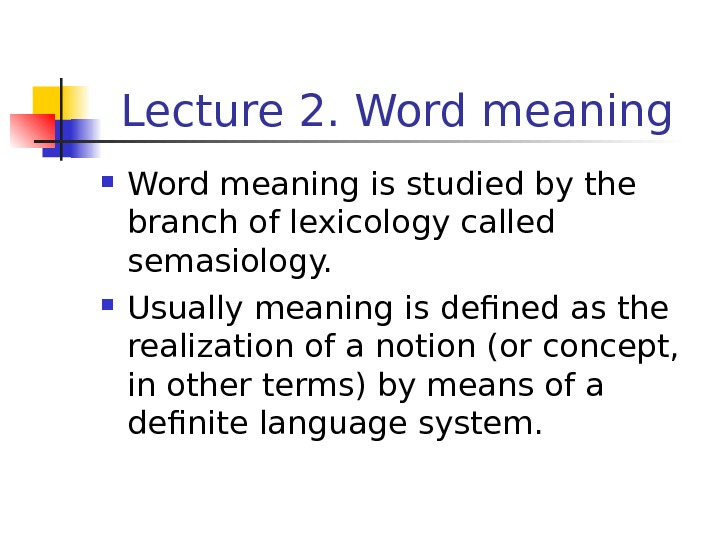

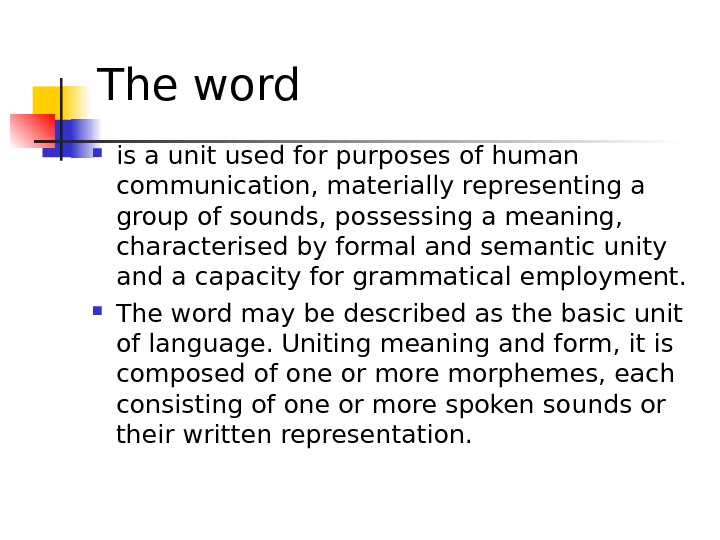
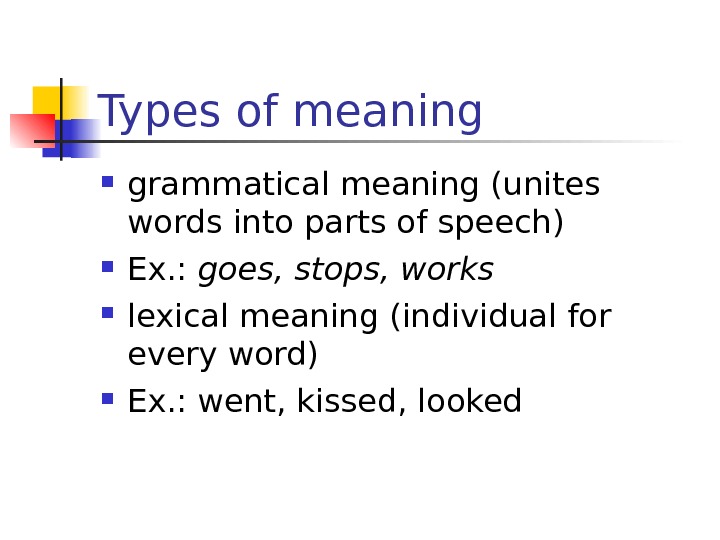
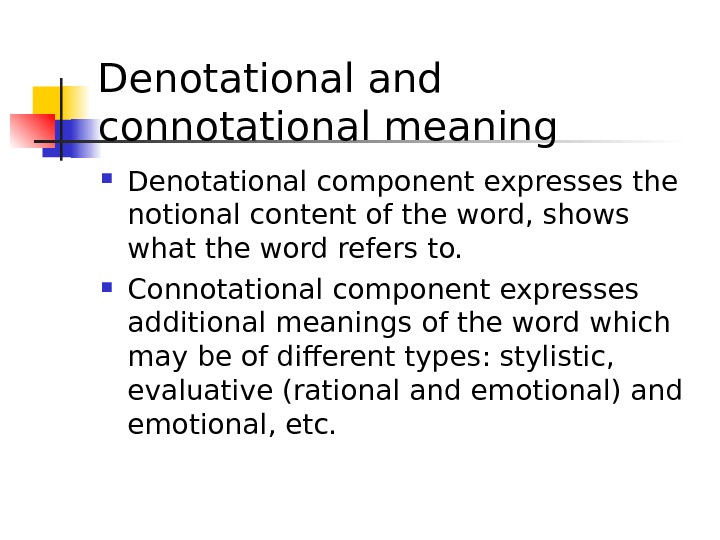




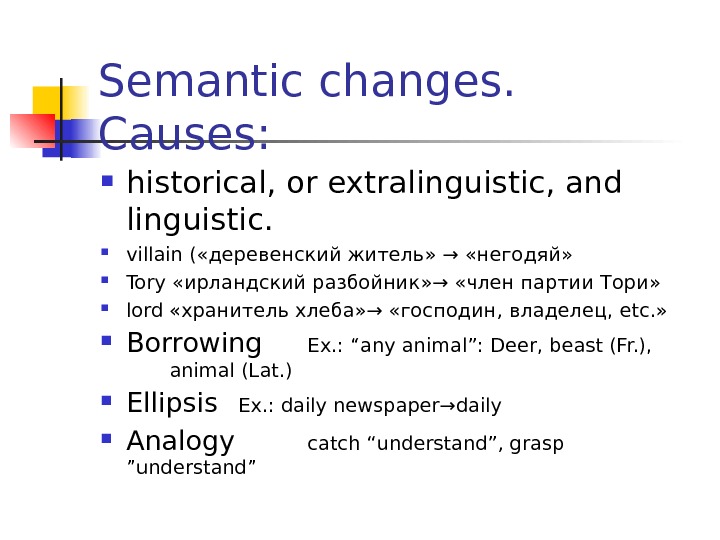
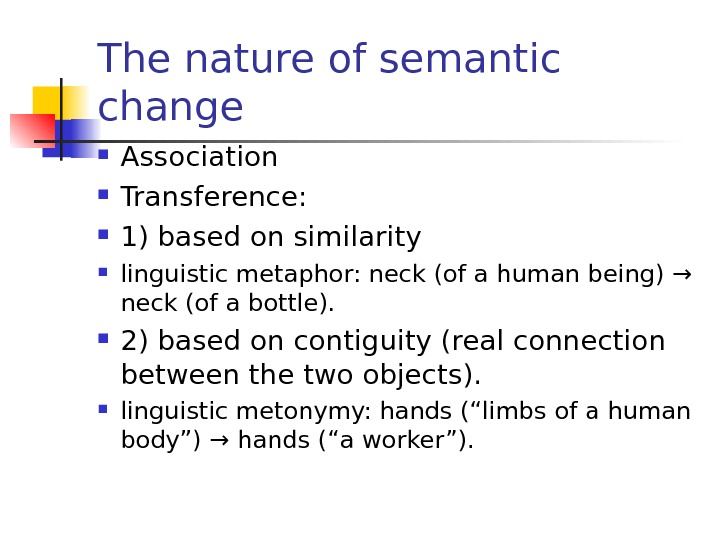
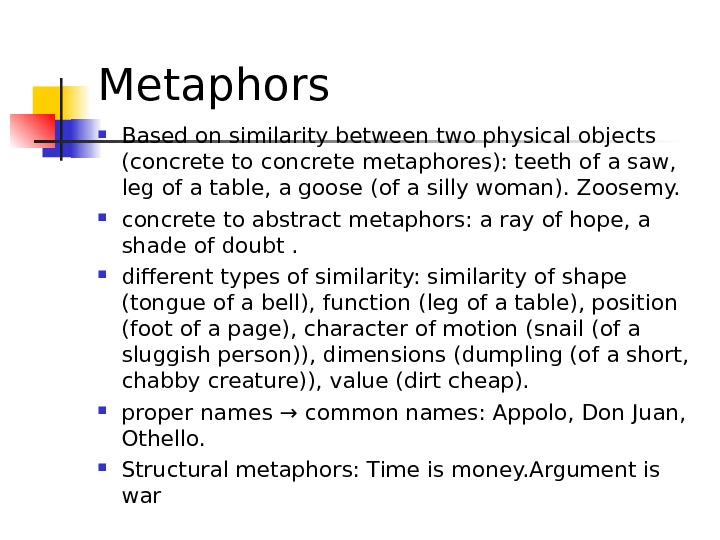



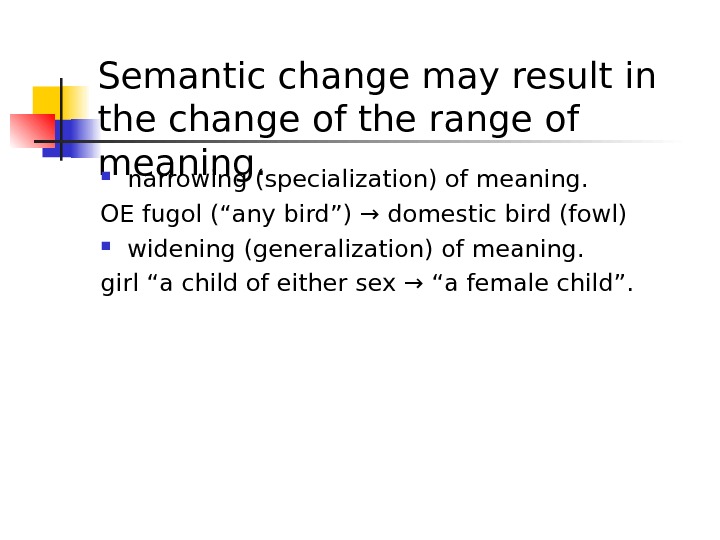

3.1. The object of semasiology. Two approaches to the study of meaning.
3.2. Types of meaning.
3.3. Meaning and motivation.
3.1. The branch of lexicology which studies meaning is called » semasiology «. Sometimes the term » semantics » is used as a synonym to semasiology, but it is ambiguous as it can stand as well for (1) the expressive aspect of language in general and (2) the meaning of one particular word.
Meaning is certainly the most important property of the word but what is » meaning»?
Meaning is one of the most controversial terms in lexicology. At present there is no generally accepted definition of meaning. Prof. Smirnitsky defines meaning as » a certain reflection in the mind of objects, phenomena or relations that makes part of the linguistic sign, its so-called inner facet, whereas the sound form functions as its outer facet». Generally speaking, meaning can be described as a component of the word through which a concept is communicated, enabling the word to denote objects in the real world.
There are two approaches to the study of meaning: the referential approach and the functional approach. The former tries to define meaning in terms of relations between the word (sound form), concept (notion, thought) and referent (object which the word denotes). They are closely connected and the relationship between them is represented by » the semiotic triangle» (= the basic triangle) of Ogden and Richards (in the book » The Meaning of Meaning» (1923) by O.K. Ogden and I.A. Richards).


 |
symbol referent
(sound form)
This view denies a direct link between words and things, arguing that the relationship can be made only through the use of our minds. Meaning is related to a sound form, concept and referent but not identical with them: meaning is a linguistic phenomenon while neither concept nor referent is.
The main criticism of this approach is the difficulty of identifying » concepts»: they are mental phenomena and purely subjective, existing in the minds of individuals. The strongest point of this approach is that it connects meaning and the process of nomination.
The functional approach to meaning is less concerned with what meaning is than with how it works. It is argued, to say that » words have meanings» means only that they are used in a certain way in a sentence. There is no meaning beyond that. Ludwig Wittgenstein (1889-1951), in particular, stressed the importance of this approach in his dictum: » The meaning of the word is its use in the language». So meaning is studied by making detailed analyses of the way words are used in contexts, through their relations to other words in speech, and not through their relations to concepts or referents.
Actually, the functional approach is basically confined to the analysis of sameness or difference of meaning. For example, we can say that in » take the bottle » and » take to the bottle » take has different meaning as it is used differently, but it does not explain what the meaning of the verb is. So the functional approach should be used not as the theoretical basis for the study of meaning, but only as complementary to the referential approach.
3.2. Word meaning is made up of different components, commonly known as types of meaning. The two main types of meaning are grammatical meaning and lexical meaning.
Grammatical meaning belongs to sets of word-forms and is common to all words of the given part of speech,
e.g. girls, boys, classes, children, mice express the meaning of » plurality».
Lexical meaning belongs to an individual word in all its forms. It comprises several components. The two main ones are the denotational component and the connotational component.
The denotational (= denotative) component, also called » referential meaning» or » cognitive meaning», expresses the conceptual (notional) content of a word; broadly, it is some information, or knowledge, of the real-world object that the word denotes. Basically, this is the component that makes communication possible.
e.g. notorious » widely-known», celebrated » known widely».
The connotational (connotative) component expresses the attitude of the speaker to what he is saying, to the object denoted by the word. This component consists of emotive connotation and evaluative connotation.
1) Emotive connotation (= » affective meaning», or an emotive charge),
e.g. In » a single tree » single states that there is only one tree, but » a lonely tree » besides giving the same information, also renders (conveys) the feeling of sadness.
We shouldn’t confuse emotive connotations and emotive denotative meanings in which some emotion is named, e.g. horror, love, fear, etc.
2) Evaluative connotation labels the referent as » good» or » bad»,
e.g. notorious has a negative evaluative connotation, while celebrated a positive one. Cf.: a notorious criminal/liar/ coward, etc. and a celebrated singer/ scholar/ artist, etc.
It should be noted that emotive and evaluative connotations are not individual, they are common to all speakers of the language. But emotive implications are individual (or common to a group of speakers), subjective, depend on personal experience.
e.g. The word » hospital » may evoke all kinds of emotions in different people (an architect, a doctor, an invalid, etc.)
Stylistic connotation, or stylistic reference, another component of word meaning, stands somewhat apart from emotive and evaluative connotations. Indeed, it does not characterize a referent, but rather states how a word should be used by referring it to a certain functional style of the language peculiar to a specific sphere of communication. It shows in what social context, in what communicative situations the word can be used.
Stylistically, words can be roughly classified into literary, or formal (e.g. commence, discharge, parent), neutral (e.g. father, begin, dismiss) and non-literary, or informal (e.g. dad, sack, set off).
3.3. The term » motivation » is used to denote the relationship between the form of the word, i.e. its sound form, morphemic composition and structural pattern, and its meaning.
There are three main types of motivation: phonetic, morphological and semantic.
1) Phonetic motivation is a direct connection between the sound form of a word and its meaning. There are two types of phonetic motivation: sound imitation and sound symbolism.
a) Sound imitation, or onomatopoeia: phonetically motivated words are a direct imitation of the sounds they denote (or the sounds produced by actions or objects they denote),
e.g. buzz, swish, bang, thud, cuckoo.
b) Sound symbolism. It’s argued by some linguists that the sounds that make up a word may reflect or symbolise the properties of the object which the word refers to, i.e. they may suggest size, shape, speed, colour, etc.
e.g. back vowels suggest big size, heavy weight, dark colour, front vowels suggest lightness, smallness, etc.
Many words beginning with sl- are slippery in some way: slide, slip, slither, sludge, etc. or pejorative: slut, slattern, sly, sloppy, slovenly; words that end in -ump almost all refer to some kind of roundish mass: plump, chump, rump, hump, stump.
Certainly, not every word with these phonetic characteristics will have the meaning suggested. This is, perhaps, one of the reasons why sound symbolism is not universally recognized in linguistics.
2) Morphological motivation is a direct connection between the lexical meaning of the component morphemes, the pattern of their arrangement and the meaning of the word.
Morphologically motivated words are those whose meaning is determined by the meaning of their components,
e.g. re-write » write again», ex-wife » former wife».
The degree of morphological motivation may be different. Words may be fully motivated (then they are transparent), partially motivated and non-motivated (idiomatic, or opaque).
a) If the meaning of the word is determined by the meaning of the components and the structural pattern, it is fully motivated: e.g. hatless.
b) If the connection between the morphemic composition of a word and its meaning is arbitrary, the word is non-motivated, e.g. buttercup » yellow-flowered plant».
c) In hammer -er shows that it is an instrument, but what is » hamming «? » Ham » has no lexical meaning in this word, thus the word is partially motivated. Cf. also cranberry.
Motivation may be lost in the course of time,
e.g. in OE wī fman was motivated morphologically: wī f + man » wife of a man»; now it is opaque; its motivation is said to be faded (woman).
3) Semantic motivation is based on co-existence of direct and figurative meanings of the same word,
e.g. butterfly – 1) insect; 2) showy and frivolous person.(= metaphorical extension of the direct meaning).
|
Шрифт зодчего Шрифт зодчего состоит из прописных (заглавных), строчных букв и цифр… |
Картограммы и картодиаграммы Картограммы и картодиаграммы применяются для изображения географической характеристики изучаемых явлений… |
Практические расчеты на срез и смятие При изучении темы обратите внимание на основные расчетные предпосылки и условности расчета… |
Функция спроса населения на данный товар Функция спроса населения на данный товар: Qd=7-Р. Функция предложения: Qs= -5+2Р,где… |







